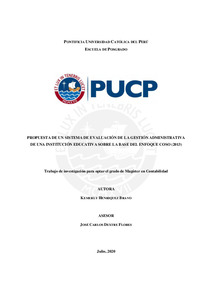Propuesta de un sistema de evaluación de la gestión administrativa de una institución educativa sobre la base del enfoque COSO (2013)
Abstract
El presente trabajo de investigación se desarrolla en la Institución Educativa Particular (I.E.P.) Isaac
Newton S.A.C., que brinda servicios educativos en los niveles de inicial primaria y secundaria. Esta
investigación está orientada a identificar los factores que afectan el cumplimiento de los objetivos
institucionales determinados por los directivos, los cuales están dirigidos al crecimiento, rentabilidad
económica y calidad del servicio para el aseguramiento de su sostenibilidad en el tiempo.
Con el fin de identificar las causas de los principales problemas de rentabilidad y atraso en el cobro de
pensiones que impactan en la liquidez de la entidad, se realizaron entrevistas estructuradas a la
administración para conocer la institución. También, se analizó su entorno y la forma cómo opera dentro
de él. Asimismo, se elaboraron cuestionarios tomando como referencia el enfoque COSO, para
comprender el nivel de desarrollo de organización de la I.E.P. y conocer las actividades y controles de
sus principales procesos administrativos, así como la forma de gestionarlos. Además, se representaron
mediante flujogramas los procesos mencionados para determinar los riesgos que, de materializarse,
afectarían el logro de los objetivos determinados por la gerencia.
Producto de todo el análisis realizado, se encontraron los resultados, alineados a las funciones de la
gestión administrativa: planeación, organización, dirección y control de las razones que afectan el logro
de las metas deseadas. Para concluir, con el fin de medir los riesgos determinados por los flujogramas y
poder gestionarlos mediante controles sugeridos, se propone instrumentos de gestión de riesgos,
llamadas matrices de riesgos y controles, para cada proceso analizado: admisión, matrícula, facturación
y cobranza; gestión de cobranza por morosidad; reclutamiento y selección del personal; y cálculo y pago
de planillas. The current research, aims to identify the factors that affect the fulfillment of the institutional objectives
of the Private Educational Institution Isaac Newton S.AC at the primary and secondary school levels.
These institutional objectives – determined by the management- are conducted to achieve economical
profitability, growth, and quality of the services which provide sustainability through time.
In order to identify the causes of the main problems of profitability and arrears in the collection of
monthly payments which impact the liquidity of the institution, structured interviews were conducted
with the management. Also, an analysis of the environment and the way it operates was developed.
Likewise, questionnaires were prepared using the COSO approach to understand the level of
organizational development of the institution and to learn about the activities and controls of its main
administrative processes, as well as how to manage them. In addition, the processes mentioned above
were represented by means of flowcharts to determine the risks that, if materialized, would affect the
achievement of the objectives determined by the management.
As a result of the analysis, the results were aligned with the functions of administrative management:
planning, organization, direction and control of the reasons that affect the achievement of the desired
goals. To conclude, in order to measure the risks determined by the flowcharts and to be able to manage
them by means of suggested controls; there is a proposition of risk management tools, which are
developed as risk and control matrices, and analyze for each process the following: admission,
registration, billing and collection; collection management for delinquency; recruitment and selection
of personnel; and calculation and payment of payroll.
Temas
Administración de riesgos
Control interno
Empresas--Organización
Control interno
Empresas--Organización
Para optar el título de
Magíster en Contabilidad
Collections
The following license files are associated with this item:






